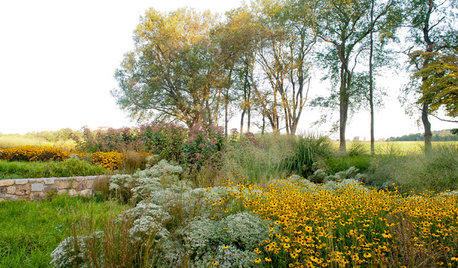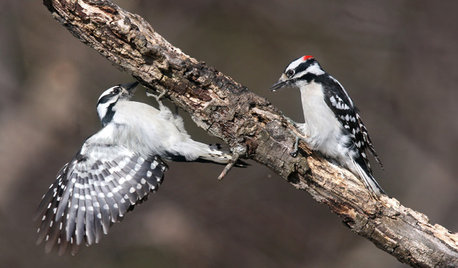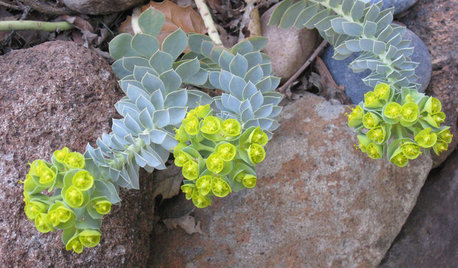The following article was written by a Master Gardener and vet and was printed in the Rockport Pilot. I thought it might be helpful for some of us "animal lovers" that are also gardeners.
Toxic plants for pets identified
By JEANNA GODFREY
Gardener's love their pets just as much as they love their petunias, but unfortunately, every year in the United States, several hundred pets die after consuming plants which are toxic to them.
Regardless of the type or size of pet, knowing the potential toxicity of all their indoor and outdoor plants is vital. Numerous ornamental plants as well as some parts of commonly-grown vegetables are toxic if consumed by our furry or feathered friends. Recognizing what plant might pose a toxic threat and what to do if an exposure is suspected may save your pet's life.
Each year the American Society for the Prevention of Cruelty to Animals publishes a list of the 10 most common poisonous plants based on data gathered through their National Animal Poison Control hotline. Currently the top 10 are marijuana, sago palm, lilies, tulip/narcissus bulbs, azalea/rhododendrons, oleander, castor bean, cyclamen, kalanchoe, and yew. This list is based on frequency of reporting, not degree of toxicity. So while marijuana is the most frequently reported toxicity, it is much less life-threatening to your pet than nibbling on castor bean, oleander, or sago palms. You can obtain more in-depth information about plant toxicities at the ASPCA website and the number for the Poison Control Center. The center is manned 24/7/365 by veterinarians especially trained to deal with toxicities.
In the majority of cases, all parts of a toxic plant are poisonous. Such is the case with oleander. With other plants, only certain parts contain the toxic principal. Tulip bulbs are toxic, yet the flowers or stems pose no problem. There are also species differences. Dogs are the only species (at least at this time) known to exhibit toxicity to grapes and raisins. Cats are the only species susceptible to the effects of lilies (Easter lily and daylily). An animal's age as well as any pre-existing health conditions can influence the severity of toxicity
Among popular local ornamentals, the oleander stands out as one of the most potentially deadly plants for your pet. All parts of the plant are poisonous, even water in which oleander has soaked. Sadly, there are many cases each year where well-intentioned gardeners have tossed oleander trimmings to neighboring horses or cattle thinking they are giving them a green treat. Even a relatively small consumption of the cardiac glycoside-containing leaves causes death due to abnormal heart function. Kalanchoe contains a similar toxic component as oleander, also producing heart arrhythmias and death if eaten in sufficient quantity.
Another popular and attractive plant villain is the sago palm. Not a true palm, all parts of this cycad are poisonous, most especially the seeds or nuts. Even if a pet eats just one or two seeds, it can become seriously ill or die due to liver failure. Other plants with seeds especially toxic to pets include morning glory and moonvine, bluebonnets, datura species, jatropha species, and Texas mountain laurel. If you soak your seeds overnight to scarify them prior to planting, make sure to keep them away from your pets.
It is beyond the scope of this article to thoroughly cover all the potentially toxic plants grown locally. Pet owners are urged to ask their veterinarian any questions they may have concerning plants in their specific landscapes. If you know or suspect your pet has eaten a toxic plant, the first thing to do is not panic. Collect some of the plant or seed consumed and call your veterinarian or the ASPCA Poison Control Center for further advice. If your pet is having seizures, losing consciousness or having difficulty breathing, get to your veterinarian or an emergency veterinary facility immediately.
For more information or questions about local gardening, contact an Aransas/San Patricio Master Gardener at the Texas Cooperative Extension Agency's Aransas County Office, by email at aransas-tx@tamu.edu, by phone 790-0103, or Mondays through Fridays from 8 a.m. until 5 p.m., at 611 East Mimosa St.
Visit the extension webpage and Master Gardener newsletter at aransas-tx.tamu.edu.
Extension education programs serve people of all ages, regardless of socioeconomic level, race, color, sex, religion, handicap or national origin.
Green Acres Demonstration Garden is co-located with Texas Cooperative Extension, Aransas County Office. The gardens are free and open to the public during daylight hours, seven days a week.













carrie751
pjtexgirl
Related Discussions
can u help me identifi this plant please
Q
can u identify plant
Q
Can u identify this butterfly please?
Q
u/i plant
Q
justintx
denisew
ltcollins1949Original Author
little_dani